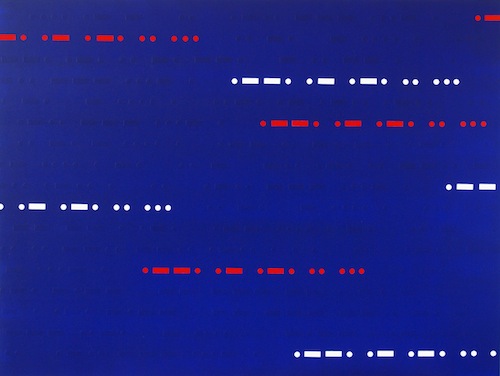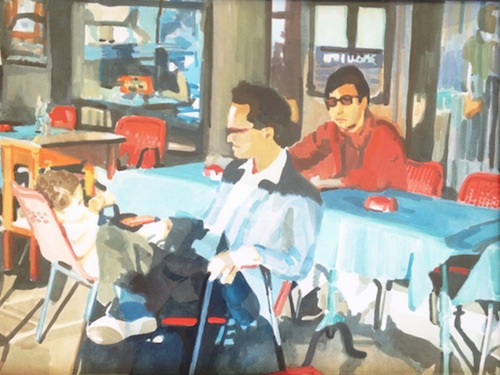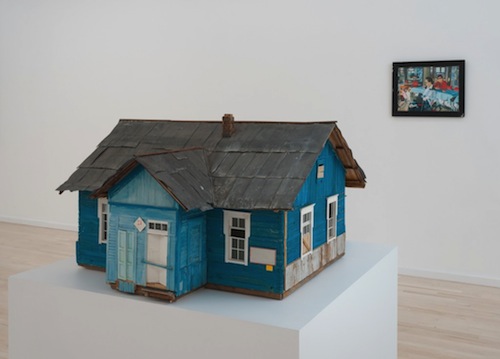Two gallery exhibitions in Los Angeles this past year continue to linger in my memory: one by the artist Jow at Marine Contemporary, and the other by Tim Braden at Ambach and Rice. Each artist attempted to evoke faraway, exotic, and glamorous places, connecting distant places and ideas within a single body of work. Using diametrically different approaches—Braden manipulating nostalgia and memories where Jow manipulates symbols and codes—the artists vividly brought these sites to life and questioned the verity of popular perceptions and representations.
An L.A.–based, Canadian-born, New York transplant, Jow had her second solo show, titled Tourist, in the spring. Jow’s work could be described, in the parlance of a Hollywood pitch, as the pop intelligence of Ed Ruscha meets the playful obscurity of Guy de Cointet. Such a cheesy shorthand description is actually not out of place when talking about Jow, who employs a light, deadpan humor and is not afraid to traffic in clichés; one of the bright neon signs in her show read, “Wish you were beer.”
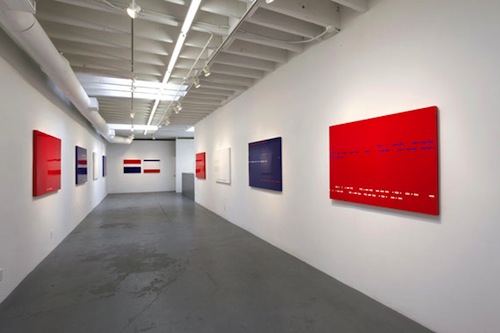
Jow. “Tourist” installation at Marine Contemporary, Venice, California, 2013. Courtesy the artist and Marine Contemporary.
Tourist featured abstract acrylic and polyurethane paintings named after popular destinations such as Tokyo, London, Paris, and New York. Each work was a Morse code translation of a song about a city in the colors of the country’s national flag. Thus, the words to Ella Fitzgerald’s “I Love Paris” formed a series of red and white dashes and dots across a blue background, while Joni Mitchell’s “A Case of You” informed a small group of white marks on a red background, signifying Canada. These paintings carry a beautiful contradiction—loaded with history, nationalism, and sentiment but delivered via minimalist, mathematic code.
Cheeky drawings on vintage hotel stationery complemented the large paintings while also evoking clichés. On letterhead from the notorious party palace Chateau Marmont, the artist wrote, “things go better with” in a red glittered font (mimicking that of Coca-Cola) above four lines of cocaine. Stationery for the Peninsula Hong Kong bore the words “street girls bringing sailors into the hotel must pay for rooms in advance.” Jow evokes time and place through a jarring combination of communication and myth.
British artist Tim Braden typically mixes lush representational paintings and period-specific objects. His work is as saturated and detailed as Jow’s is dry and abstract. Braden is known for his romantic depictions of exotic adventures abroad, often inspired by literature, colonial history or found photographs. His 2008 exhibition in Amsterdam, I spend my evenings sitting by the fireside hunting tigers (named after a Gustave Flaubert quote), found him constructing an imagined 1950s boyhood filled with pinewood derby races, matinée serials, and explorers’ maps of the world. This idyllic fantasy world was built around a recreation of a classroom that may or may not have been his own as a child.
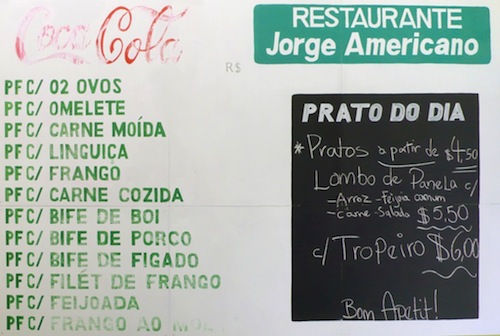
Tim Braden. “Jorge Americano Menu,” 2007. Acrylic and chalk on board. Courtesy the artist and Ambach & Rice.
A similar elision of lived and imagined experience occurred in Braden’s fall 2012 exhibition, Agence de Voyage, at Ambach and Rice. Among the works on display were oil or gouache paintings of everyday scenes; weathered signs for places like Hotel Badr and Restaurante Jorge Americano (the latter listing humble offerings like omelete and bife de porco); and a model of a rustic cabin. All of them were so richly rendered as to make you feel like you were there, however vague “there” might be.
As it turns out, Hotel Badr and Restaurante Jorge Americano were actually encountered by the artist who faithfully reproduced their signage, likely from photographs. And the model cabin, titled Datcha (2009–12), was inspired by a cabin that he saw on the outskirts of Moscow and recreated from memory. Braden’s scenes of daily life represented an intimate history too, but not one that he himself experienced; the images were derived from 1970s photographs in his wife’s family albums. Overall, Agence de Voyage illumined the rich gulf between an actual place and time and the desires and associations that we project onto them.
The phrase Agence de Voyage means “travel agency,” a pun that conveniently sums up what both of these artists are up to. Although Jow has visited each of the places her paintings are named after, she chooses to ignore specifics and explore them through universal codes. Braden’s travels also find their way into his work, but he mixes his experiences and recollections with those of others, creating a blurred subjectivity and quasi-fictional sense of longing. Both of these avid explorers play tricks on would-be armchair travelers, complicating our reception of myth and inspiring more nuanced engagement.

